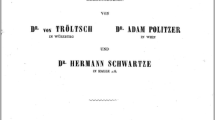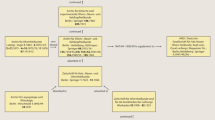Abstract
Various case reports on nasal myiasis written during the 1990s and 2000s state that nasal myiasis, which is known as peenash among South Asian natives, is a form of divine punishment in Hindu mythology, but do not provide citations from Hindu scriptures that would suggest this interpretation. This paper aims to discuss the phenomenon of peenash in a historical context by examining medical literature written during the nineteenth and early twentieth centuries, to identify Hindu texts contributing to the belief of some Hindus that nasal myiasis is a form of divine punishment, and to provide an overview of contemporary treatment for and management of nasal myiasis.


Similar content being viewed by others
References
Arora, S., Sharma, J. K., Pippal, S. K., Sethi, Y., & Yadav, A. (2009). Clinical etiology of myiasis in ENT: A reterograde period-interval study. Brazilian Journal of Otorhinolaryngology, 75(3), 356–361.
Ashrafian, H. (2009). An ancient Indian method of penis lengthening. Archives of Sexual Behavior, 38(1), 4–5. doi:10.1007/s10508-008-9417-y.
Balfour, E. (1885). The cyclopaedia of India and of Eastern and Southern Asia: Commercial, industrial, and scientific; products of the mineral, vegetable, and animal kingdoms, useful arts and manufactures (3rd ed.). London: Bernard Quaritch.
Bhatia, M. L., & Dutta, K. (1965). Myiasis of the tracheostomy wound. Journal of Laryngology and Otology, 79(10), 907–911.
Burnett, C. H. (1893). System of diseases of the ear, nose, and throat (Vol. 1). Philadelphia: J.B. Lippincott Company.
Cohen, E. S. (2007). Atlas of cosmetic and reconstructive periodontal surgery (3rd ed.). China: People’s Medical Publishing House.
Curran, W. (1887). Some rare professional life experiences: Case VII—peenash, alias vermes nasi. Medicine Press & Circle, 94, 216–218.
Droma, E. B., Wilamowski, A., Schnur, H., Yarom, N., Scheuer, E., & Schwartz, E. (2007). Oral myiasis: A case report and literature review. Oral Surgery, Oral Medicine, Oral Pathology, Oral Radiology and Endodontics, 103(1), 92–96. doi:10.1016/j.tripleo.2005.10.075.
Drury, H. (1873). The useful plants of India: With notices of their chief value in commerce, medicine, and the arts (2nd ed.). London: William H. Allen & Co.
Dutt, M. N. (1896). A prose English translation of Vishnupuranam (based on professor H.H. Wilson’s translation). Calcutta: Keshub Academy.
Dymock, W. (1885). The vegetable materia medica of Western India (2nd ed.). Bombay: Education Society’s Press.
Dymock, W., Warden, C. J. H., & Hooper, D. (1893). Pharmacographia indica: A history of the principal drugs of vegetable origin met within British India (part vi). Bombay: Education Society’s Press.
Fantham, H. B., Braun, M. G. C. C., Stephens, J. W. W., & Theobald, F. V. (1916). The animal parasites of man. New York: William Wood and Company.
Francesconi, F., & Lupi, O. (2006). Myiasis. In S. K. Tyring, O. Lupi, & U. R. Hengge (Eds.), Tropical dermatology (pp. 232–239). Philadelphia: Elsevier.
Francesconi, F., & Lupi, O. (2012). Myiasis. Clinical Microbiology Reviews, 25(1), 79–105. doi:10.1128/CMR.00010-11.
Franza, R., Leo, L., Minerva, T., & Sanapo, F. (2006). Myiasis of the tracheostomy wound: Case report. Acta Otorhinolaryngologica Italica, 26(4), 222–224.
Gealh, W. C., Ferreira, G. M., Farah, G. J., Teodoro, U., & Camarini, E. T. (2009). Treatment of oral myiasis caused by Cochliomyia hominivorax: Two cases treated with ivermectin. British Journal of Oral and Maxillofacial Surgery, 47(1), 23–26. doi:10.1016/j.bjoms.2008.04.009.
Goff, M. L., Campobasso, C. P., & Gherardi, M. (2010). Forensic implications of myiasis. In J. Amendt, C. P. Campobasso, M. L. Goff, & M. Grassberger (Eds.), Current concepts in forensic entomology (pp. 313–326). USA: Springer.
Gould, G. M., & Pyle, W. L. (1901). Anomalies and curiosities of medicine. Philadelphia: W.B. Saunders and Company.
Graham, O. H. (1979). The chemical control of screwworm: A review. Southwestern Entomologist, 4, 258–264.
Hakeem, M. J., & Bhattacharyya, D. N. (2009). Exotic human myiasis. Travel Medicine and Infectious Disease, 7(4), 198–202. doi:10.1016/j.tmaid.2009.05.007.
Hall, F. H. (1909). Maggots in the nose. In C. Allbutt & H. D. Rolleston (Eds.), A system of medicine: Vol. 4, part 2—Diseases of the nose, pharynx, larynx, trachea, and ear (pp. 59–60). London: Macmillan and Co.
James, M. T. (1947). The flies that cause myiasis in man. Washington, DC: United States Department of Agriculture.
Kahn, D. G. (1999). Myiasis secondary to Dermatobia hominis (human botfly) presenting as a long-standing breast mass. Archives of Pathology and Laboratory Medicine, 123, 829–831.
Kamboj, M., Mahajan, S., & Boaz, K. (2007). Oral myiasis misinterpreted as salivary gland adenoma. Journal of Clinical Pathology, 60, 848.
Kyle, D. B. (1916). A textbook of diseases of the nose and throat. USA: W.B. Saunders and Co.
Lahory, B. T. C. (1857). On peenash, or worms in the nose. Edinburgh Medical Journal, 2(1), 371–372.
Landeman, E. (1929). Indian Medical Gazette, 64, 657.
Lima Junior, S. M., Asprino, L., Prado, A. P., Moreira, R. W., & de Moraes, M. (2010). Oral myiasis caused by Cochliomyia hominivorax treated nonsurgically with nitrofurazone: Report of 2 cases. Oral Surgery, Oral Medicine, Oral Pathology, Oral Radiology and Endodontics, 109(3), e70–e73. doi:10.1016/j.tripleo.2009.11.014.
Macdonald, G. (1890). A treatise on diseases of the nose and its accessory cavities. London: Macmillan and Co.
Moore, W. J. (1873). Native practice in Rajpootana. Indian Annals for Medical Science, 31, 95–115.
Moore, W. J. (1877). A manual of family medicine in India (2nd ed.). London: J. & A. Churchill.
Navarra, T. (2003). The encyclopedia of asthma and respiratory disorders. USA: Infobase Publishing.
Noutsis, C., & Millikan, L. E. (1994). Myiasis. Dermatologic Clinics, 12(4), 729–736.
Olivelle, P. (2004). The law code of Manu. Great Britain: Oxford University Press.
Patterson, R. L. (1909). An Indian screw-worm. Indian Medical Gazette, 44(10), 374–376.
Patton, W. S. (1922). Notes on myiasis producing Diptera of man and animals. Bulletin of Entomological Research, 12, 239–261.
Prasanna Kumar, S., Ravikumar, A., Somu, L., Vijaya Prabhu, P., & Mundakannan Subbaiya Periyasamy Subbaraj, R. (2011). Tracheostomal myiasis: A case report and review of the literature. Case Reports in Otolaryngology, 2011, 303510. doi:10.1155/2011/303510.
Quintanilla-Cedillo, M. R., Leon-Urena, H., Contreras-Ruiz, J., & Arenas, R. (2005). The value of Doppler ultrasound in diagnosis in 25 cases of furunculoid myiasis. International Journal of Dermatology, 44(1), 34–37. doi:10.1111/j.1365-4632.2004.02471.x.
Rodríguez Morales, A. J., Barbella, R. A., Dickson, S. M., Johnston, S., & Pinto, J. A. (2006). Aspectos Histopatológicos y Parasitológicos de la Infestación Bucal por Sarcophaga haemorrhoidalis: A Propósito de Un Caso. Salus Militiae, 31(2), 45–49.
Rustomjee, B. (1860). Selection of cases from the records of the Kurrachee charitable dispensary: No. 5—worms in the nose; cured by turpentine and other injections. In W. C. Coles (Ed.), Transactions of the medical and physical society of Bombay—no. v. new series, for the year 1859 (pp. xxviii–xxix). Bombay: Education Society’s Press, Byculla.
Sharma, H., Dayal, D., & Agrawal, S. P. (1989). Nasal myiasis: Review of 10 years experience. Journal of Laryngology and Otology, 103(5), 489–491.
Shinohara, E. H., Martini, M. Z., de Oliveira Neto, H. G., & Takahashi, A. (2004). Oral myiasis treated with ivermectin: Case report. Brazilian Dental Journal, 15(1), 79–81.
Singh, I., Gathwala, G., Yadav, S. P., Wig, U., & Jakhar, K. K. (1993). Myiasis in children: The Indian perspective. International Journal of Pediatric Otorhinolaryngology, 25(1–3), 127–131.
Soni, N. K. (2000). Endoscopy in nasal myiasis. Tropical Doctor, 30(4), 225–227.
Sood, V. P., Kakar, P. K., & Wattal, B. L. (1976). Myiasis in otorhinolaryngology with entomological aspects. Journal of Laryngology and Otology, 90(4), 393–399.
Spradbery, J. P. (1994). Screw-worm fly: A tale of two species. Agricultural Zoology Reviews, 6, 1–62.
Spradbery, J. P., Tozer, R. S., Drewett, N., & Lindsey, M. J. (1985). The efficacy of ivermectin against larvae of the screw-worm fly (chrysomya bezziana). Australian Veterinary Journal, 62(9), 311–314.
Stewart, W. K. (1872). Case of development of larvae in the nasal passages Army medical department report for the year 1870, and supplement to report for 1869: (Vol. XII, pp. 529–531). London: Harrison and Sons.
Uzun, L., Cinar, F., Beder, L. B., Aslan, T., & Altintas, K. (2004). Radical mastoidectomy cavity myiasis caused by Wohlfahrtia magnifica. Journal of Laryngology and Otology, 118(1), 54–56. doi:10.1258/002221504322731655.
Vemsani, L. (2012). Worms and the corporal body in India: An examination of Hindu literary traditions. In B. Gardenour & M. Tadd (Eds.), Parasites, worms, and the human body in religion and culture (pp. 17–40). New York: Peter Lang.
Watson, C. (1901). Encyclopaedia medica (Vol. 8). New York: Longman, Greens & Co.
Wise, T. A. (1860). Commentary on the Hindu system of medicine: New issue. London: Trübner & Co.
Wishart, D. J. G. (1918). The disease ozena. Canadian Medical Association Journal, 8(7), 606–610.
Wood, E., & Subrahmanyam, S. V. (1911). The Garuda Purana (Saroddhara). Allahabad: Panini Office.
Younge, G. H. (1911). Treatment of peenash. British Medical Journal, 1(2619), 596.
Yuca, K., Caksen, H., Sakin, Y. F., Yuca, S. A., Kiris, M., Yilmaz, H., et al. (2005). Aural myiasis in children and literature review. Tohoku Journal of Experimental Medicine, 206(2), 125–130.
Zysk, K. G. (1998). Medicine in the Veda: Religious healing in the Veda, with translations and annotations of medical hymns from the Rgveda and the Atharvaveda and renderings from the corresponding ritual texts (2nd ed.). India: Motilal Banarsidass Publishing.
Author information
Authors and Affiliations
Corresponding author
Rights and permissions
About this article
Cite this article
Bosmia, A.N., Zimmermann, T.M., Griessenauer, C.J. et al. Nasal Myiasis in Hinduism and Contemporary Otorhinolaryngology. J Relig Health 56, 1263–1281 (2017). https://doi.org/10.1007/s10943-013-9817-8
Published:
Issue Date:
DOI: https://doi.org/10.1007/s10943-013-9817-8




